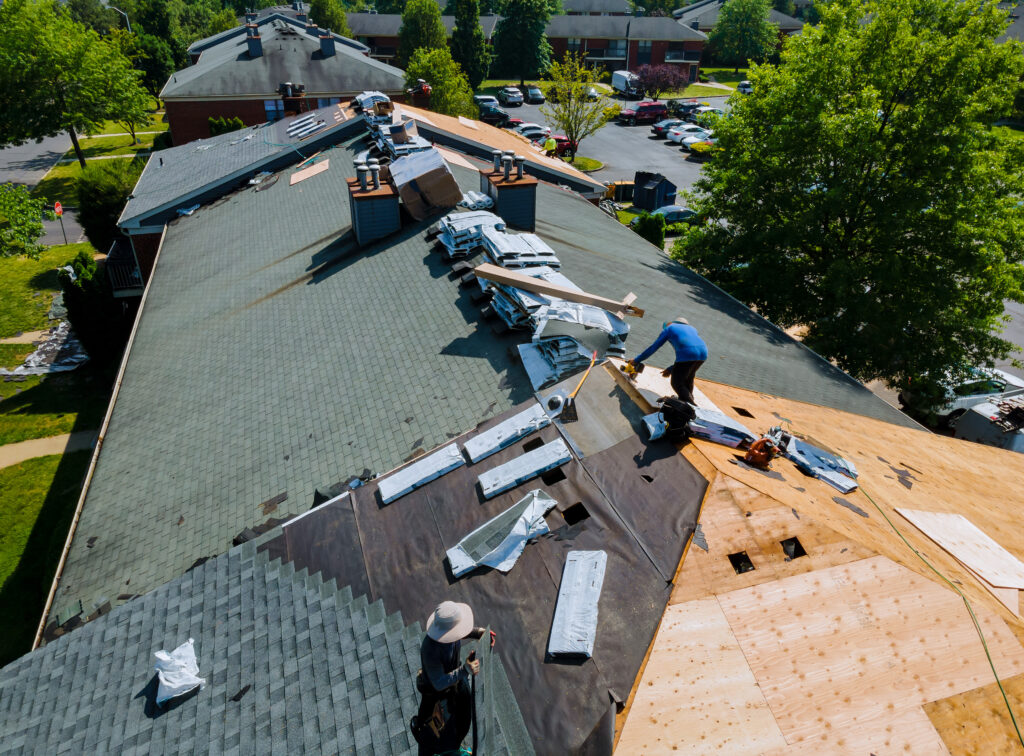Managing multiple roofing projects feels like juggling knives when you rely on scattered text messages, whiteboard schedules, and disconnected apps. Crews show up at wrong addresses, roofing materials arrive late, and clients call asking for updates you cannot provide. The right roofing project management software eliminates this chaos by organizing every aspect of your jobs in one central location.
Roofing contractors who switch from manual coordination to dedicated project management tools see immediate improvements in job completion times and customer satisfaction. These platforms help track progress, coordinate team schedules, and keep clients informed without constant phone calls. For roofing company owners and project managers tired of daily coordination headaches, comprehensive roofing software provides the structure needed to run seamless operations.
The Hidden Costs of Disorganized Project Management

Most roofing companies start with basic coordination methods like group texts and paper schedules. This approach works when you handle two or three jobs per month. But as your roofing business grows, manual systems create expensive problems that eat into profits.
Miscommunication between crews leads to costly mistakes and rework. When job details live in different places, team members show up with wrong materials or incomplete information. These errors delay projects and damage your reputation with clients who expect professional service.
Poor scheduling creates inefficient resource allocation. Without clear visibility into crew availability and project timelines, you either overbook teams or leave them idle. Both scenarios reduce profitability and frustrate your workers who want consistent schedules.
Quick tip: Roofing contractors using manual project coordination lose an average of 8 hours per week to miscommunication and scheduling conflicts, costing approximately $2,400 monthly in lost productivity.
How Roofing Software Transforms Operations

Modern roofing software centralizes all project information in one accessible platform. Job details, crew assignments, material requirements, and client communications stay organized and visible to your whole team. This transparency eliminates confusion and keeps everyone on the same page.
Automated scheduling features help coordinate crews across multiple job sites without conflicts. The system shows crew availability, project deadlines, and material delivery schedules in one view. This visibility helps you optimize resources while meeting client expectations for timely completion.
Real-time updates keep everyone informed about project changes and progress. When crews complete phases or encounter delays, updates flow automatically to relevant team members and clients. This communication reduces phone calls and improves customer satisfaction through proactive updates.
Essential Features of the Roofing Industry Management Tools

The best roofing software includes specific features that address common coordination challenges. Task assignments help break complex projects into manageable phases with clear responsibility allocation. Each team member knows exactly what they need to complete and when.
Progress tracking shows completion percentages for each project phase. Visual dashboards display which jobs are on schedule, behind timeline, or ready for next phases. This visibility helps identify potential problems before they impact client deadlines.
Integration capabilities connect your project management tools with estimating, accounting, and customer relationship management systems. These connections eliminate double data entry and ensure information consistency across your entire business operations.
Roofing Project Management That Actually Works

Effective project coordination starts with proper job setup and planning. The system should create detailed project schedules based on scope, crew size, and material requirements. Clear timelines help set realistic client expectations while providing accountability for your teams.
Resource allocation features help assign the right crews to appropriate projects based on skills and availability. You can match experienced teams with complex commercial projects while assigning routine maintenance to newer crew members. This optimization improves quality while developing team capabilities.
Material coordination ensures supplies arrive when crews need them without excess inventory costs. The platform can track delivery schedules, notify suppliers of timing changes, and alert teams about material availability. This coordination prevents project delays caused by supply chain issues.
Roofing Estimating Software Integration Benefits

Combining project management with roofing estimating software creates seamless workflows from initial quotes through project completion. Once you win a contract, project details transfer automatically from estimates into management systems. This integration eliminates manual data entry and reduces setup errors.
Accurate roofing estimates provide the foundation for realistic project planning. When your estimating tools calculate precise material quantities and labor requirements, project schedules become more reliable. Clients receive accurate timelines while your teams get achievable targets.
Budget tracking compares actual costs against original estimates throughout project execution. You can identify cost overruns early and take corrective action before they impact profitability. This visibility helps refine future estimates while protecting margins on current jobs.
For roofing contractors looking to improve their estimation accuracy and speed, comprehensive estimating tools work hand-in-hand with project management systems. Learn more about creating precise quotes in our guide on creating accurate estimates quickly.
Customer Relationship Management During Projects

Professional client communication becomes easier when project information stays organized and accessible. Instead of searching through texts and emails for job details, your office staff can provide immediate updates about project status, crew schedules, and completion timelines.
Automated notifications keep clients informed about project milestones without requiring manual updates from your team. The system can send progress reports, schedule confirmations, and completion alerts automatically. This communication builds trust while reducing administrative work for your office staff.
Issue resolution improves when you have complete project histories and communication records. If clients have concerns or questions, you can review all previous interactions and project details quickly. This preparation helps resolve problems professionally while maintaining positive relationships.
Best Roofing Software for Growing Companies

The most effective platforms scale with your roofing business growth without requiring system changes. Cloud-based solutions provide access from any location while maintaining data security through professional hosting services. Your teams can update project information from job sites using mobile devices.
User permissions control who can access sensitive information like pricing and profit margins. Project managers can view financial data while crew members see only job-specific details they need. These security controls protect your business while maintaining appropriate access levels.
Integration with other business tools creates comprehensive management solutions. The best roofing software connects with accounting systems, supplier catalogs, and customer databases. These connections streamline operations while providing complete business visibility.
Did you know? Roofing companies using integrated software platforms reduce administrative time by 35% because information flows automatically between estimating, project management, and accounting functions.
Mobile App Functionality for Field Teams

Modern roofing project management requires mobile access that works reliably from any job site. Crew members need to update progress, access project details, and communicate with the office without returning to headquarters. Quality mobile app solutions provide this connectivity through smartphones and tablets.
Photo documentation capabilities help track project progress and quality control. Before and after pictures provide proof of completed work while supporting warranty claims. Visual updates keep clients informed and protect your roofing business from liability issues.
Time tracking features help monitor labor costs and productivity across different project types. Crews can clock in and out of specific job phases, providing data for future estimates and performance analysis. This information helps optimize crew assignments and improve profitability.
Professional Proposals and Client Communication

Integrated proposal generation creates polished estimates that impress potential clients while providing detailed project information. The system can include timeline projections, material specifications, and team qualifications in professional documents. These comprehensive proposals help close more jobs by demonstrating expertise and organization.
Contract management simplifies agreement processing and client approvals. Digital signature capabilities allow immediate contract execution without printing and mailing delays. Fast approval processes help secure projects before clients change their minds or accept competitor offers.
Progress reporting keeps clients informed throughout project execution without requiring constant phone calls. Automated reports can include completion percentages, upcoming milestones, and any schedule adjustments. This transparency builds trust while reducing communication overhead for your team.
Roofing Jobs Coordination and Scheduling

Multi-project visibility helps coordinate resources across different job sites without conflicts. The platform shows crew assignments, equipment allocation, and material deliveries in one comprehensive view. This transparency helps prevent double-booking while optimizing resource utilization.
Weather integration helps adjust schedules based on forecast conditions. Roofing work depends heavily on weather, so having automated alerts about rain or wind helps reschedule work proactively. According to the National Weather Service, proper weather planning can prevent 80% of weather-related work stoppages when crews receive 24-hour advance notice. This planning prevents crew downtime while maintaining safety standards.
Subcontractor coordination becomes easier when everyone has access to current project information and schedules. External teams can view their assignments, access job details, and update progress through the same platform. This integration improves communication while maintaining project accountability.
Document Management for Project Records

Centralized document storage keeps all project paperwork organized and accessible throughout job execution. Contracts, permits, insurance certificates, and inspection reports stay connected to specific projects. Your team can find any document quickly without searching through filing cabinets or email attachments.
Version control ensures everyone works with current information when project specifications change. The system tracks document revisions and notifies relevant team members about updates. This accuracy prevents costly mistakes from outdated plans or specifications.
Photo and file sharing capabilities let field teams upload progress pictures and documentation directly to project records. These updates provide real-time visibility into job progress while creating permanent records for warranty and liability purposes.
Roofing Software Built for Industry Needs

Industry-specific features address common roofing challenges that generic project management tools cannot handle. Aerial measurements integration provides quick roof calculations for change orders and additional work. Weather tracking helps plan work schedules around forecast conditions.
Material integration with supplier catalogs streamlines ordering and delivery coordination. The platform can connect directly with suppliers like ABC Supply to check availability, compare prices, and track deliveries. This integration reduces ordering errors while improving inventory management.
Safety compliance features help track certifications, training requirements, and incident reporting. The system can alert managers when certifications expire or safety training needs renewal. This monitoring helps maintain insurance compliance while protecting worker safety.
Instant Roof Estimates for Change Orders

Quick estimating capabilities help price additional work during project execution without delaying progress. When clients request changes or crews discover unexpected issues, you can generate instant roof estimates for approval. This speed helps maintain project momentum while ensuring profitable pricing.
Change order tracking documents all project modifications and their impact on timelines and costs. The system maintains complete records of original scope versus final completion for accurate billing and future reference. This documentation prevents disputes while ensuring proper compensation.
Integration with main project schedules shows how changes affect completion dates and resource requirements. Clients can see timeline impacts before approving additional work, helping them make informed decisions about project modifications.
Accurate Measurements and Quality Control

Precision measurement tools help verify work completion and material usage against original estimates. Digital measurements provide objective data for quality control and client verification. This accuracy protects against disputes while ensuring projects meet specifications.
Inspection checklists help maintain quality standards across different crews and project types. Standardized procedures ensure consistent work quality while providing documentation for warranty purposes. These controls protect your reputation while reducing callback costs.
Progress verification features confirm completion percentages before triggering payment requests or advancing to next project phases. Objective measurements prevent overcharging while ensuring appropriate compensation for completed work.
Quick tip: Roofing contractors who implement digital quality control processes reduce callbacks by 45% because standardized checklists catch issues before project completion.
More Contractors Choose Integrated Solutions

The roofing software market moves toward comprehensive platforms that handle every business function in one system. Instead of using separate applications for estimating, project management, and customer service, more contractors choose integrated solutions that streamline repetitive tasks.
Cost efficiency improves when you eliminate multiple software subscriptions and reduce training requirements. One platform with multiple functions costs less than several specialized applications while providing better data integration. Your team learns one system instead of juggling multiple interfaces.
Data consistency improves when all business functions share the same database. Customer information, project details, and financial data stay synchronized automatically. This integration eliminates errors from manual data transfer while providing complete business visibility.
Advanced Features That Save Time and Money

Automated workflow capabilities handle routine tasks without manual intervention. The system can generate purchase orders, send progress updates, and schedule follow-up appointments automatically. This automation frees your team to focus on productive work instead of administrative tasks.
Predictive analytics help identify potential project delays or cost overruns before they occur. The platform analyzes historical data to predict completion times and identify risk factors. This insight helps you take preventive action while managing client expectations proactively.
Resource optimization features suggest crew assignments and scheduling improvements based on project requirements and team capabilities. These recommendations help maximize productivity while maintaining quality standards across different project types.
Payment Processing and Financial Integration

Streamlined billing processes generate invoices automatically based on project milestones and completion percentages. Integration with accounting software ensures accurate financial records without double data entry. This automation improves cash flow while reducing administrative overhead.
Payment tracking shows which invoices are outstanding and manages collection follow-up automatically. The system can send payment reminders and track client payment patterns for credit decisions. This visibility helps maintain healthy cash flow while preserving customer relationships.
Cost analysis provides insights into project profitability and identifies opportunities for improvement. You can analyze which project types generate the best margins and adjust your business focus accordingly. This data helps optimize pricing strategies while improving overall profitability.
Understanding how to collect payments efficiently complements effective project management by ensuring cash flow remains strong throughout project execution. Learn more about streamlining your billing processes in our guide about payment collection strategies.
Team Collaboration Across Multiple Locations

Multi-location support helps roofing companies coordinate operations across different territories while maintaining centralized oversight. Each location can manage local projects while sharing resources and best practices through the central platform. This scalability supports business growth without losing operational control.
Real-time communication tools keep teams connected regardless of physical location. Instant messaging, file sharing, and video calling capabilities help resolve issues quickly without requiring travel between job sites. This connectivity improves efficiency while reducing coordination costs.
Performance tracking provides insights into team productivity and project success rates across different locations and crew configurations. These analytics help identify best practices and training opportunities while optimizing resource allocation across your entire organization.
Measuring Success and Return on Investment

Time savings metrics help quantify the value of project management software implementation. Track how much time your team saves on coordination, communication, and administrative tasks. These measurements justify the software investment while identifying areas for further improvement.
Customer satisfaction improvements often result from better communication and more reliable project completion. Monitor client feedback and referral rates to measure the impact of improved project management. Satisfied customers provide valuable referrals that help grow your business.
Profitability analysis shows how better project coordination affects your bottom line. Reduced delays, fewer errors, and improved resource utilization all contribute to better margins. Track these improvements to understand the full financial impact of your software investment.
Frequently Asked Questions
What is roofing project management software and how does it help my business?
Roofing software centralizes all your job coordination, crew scheduling, and client communication in one platform. Projul helps roofing contractors track multiple projects simultaneously, coordinate teams efficiently, and keep clients informed about progress. The system eliminates the chaos of scattered text messages and disconnected apps that often lead to costly mistakes and delays.
How does roofing software improve team coordination?
Projul provides real-time visibility into crew schedules, job assignments, and project progress across all your active jobs. Your whole team can access current information from mobile devices, eliminating confusion about where they should be and what work needs completion. Automated notifications keep everyone updated about schedule changes and project milestones.
Can project management software really reduce project delays?
Yes, roofing companies using dedicated project management platforms typically see 25-40% fewer delays. Projul helps prevent common delay causes like material shortages, crew scheduling conflicts, and miscommunication. The system coordinates deliveries, tracks weather impacts, and ensures teams have current project information before arriving at job sites.
How does Projul integrate with my existing business processes?
Projul connects seamlessly with your estimating, accounting, and customer management systems to create a complete business solution. Information flows automatically between different functions, eliminating double data entry and ensuring consistency. You can continue using preferred suppliers and subcontractors while gaining better coordination capabilities.
What mobile features help my field crews stay productive?
Projul’s mobile app lets crews access job details, update progress, upload photos, and communicate with the office from any job site. Teams can view project specifications, check material deliveries, and report completion status without phone calls. This connectivity keeps projects moving efficiently while reducing administrative interruptions.
How does the software help with client communication during projects?
Projul automates client updates about project progress, schedule changes, and completion milestones without requiring manual effort from your team. Clients receive professional reports with photos and timeline information, building trust while reducing phone calls to your office. The system maintains complete communication history for reference during any client interactions.
Can the software handle both residential and commercial projects?
Absolutely. Projul scales from small residential repairs to large commercial installations with features appropriate for each project type. The platform handles complex multi-phase commercial projects while maintaining simplicity for routine residential work. Customizable templates adapt to your specific project requirements and business processes.
How quickly can my team start using project management software?
Most roofing teams can begin using Projul within a few days of setup. The platform includes industry-specific templates and intuitive interfaces designed for roofing contractors. We provide comprehensive training and data migration support to ensure smooth transitions without disrupting your ongoing projects.
What kind of reporting and analytics does Projul provide?
Projul offers detailed insights into project profitability, team productivity, and client satisfaction metrics. You can analyze completion times, cost performance, and resource utilization across different project types. These analytics help optimize operations while identifying opportunities for business improvement and growth.
How does Projul support business growth and expansion?
Projul scales with your business growth, handling increased job volumes and additional team members without system limitations. The platform supports multiple locations while maintaining centralized oversight and reporting. As your roofing business expands, Projul adapts to new requirements while preserving your operational efficiency and project coordination capabilities.
Choosing Roofing Software That Grows With Your Business

Scalability considerations become important as your roofing business expands into new markets or service areas. The platform should handle increased job volumes, additional team members, and expanded service offerings without requiring system changes. This flexibility protects your software investment while supporting business growth.
Training requirements affect how quickly your team can adopt new systems and realize benefits. Look for platforms with intuitive interfaces and comprehensive support resources. Good training programs help ensure successful implementation while minimizing productivity disruption during transitions.
Support quality affects your long-term success with any software platform. Choose providers that offer responsive technical support, regular system updates, and industry-specific expertise. Quality support helps resolve issues quickly while ensuring you maximize the platform benefits.
For a comprehensive overview of all available software options and how they work together to support your roofing business, explore our detailed analysis in The Ultimate Guide to Roofing Contractor Software.
